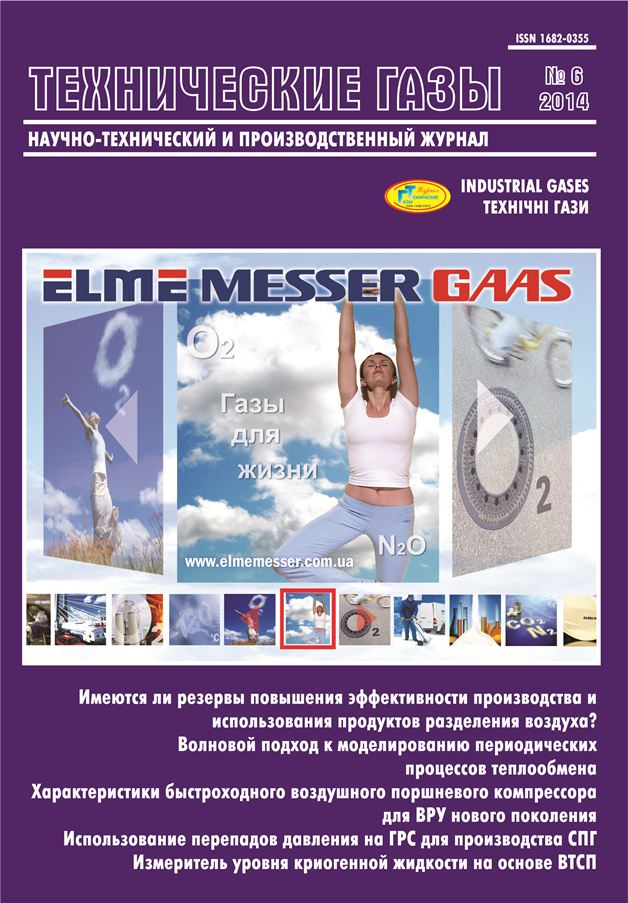PRESSURE DROP AT GAS-DISTRIBUTION STATIONS USING FOR NATURAL GAS LIQUEFACTION
DOI:
https://doi.org/10.18198/j.ind.gases.2014.0755Keywords:
Liquefied natural gas (LNG), Gas-distribution station, Work of liquefaction, Expander cycle, Flow recirculation, Carbon dioxide removalAbstract
Liquefied natural gas share in the world consumption of natural gas increases annually. Theoretically, the minimum expenditure of energy to produce LNG in amount 1 kg is 0,26 ... 0,29 kWh from the initial state at standard conditions. It is advisable to use the potential energy, which is lost when gas reduces from main pipeline pressure to distributive pipeline pressure at gas stations for LNG production. The Ukrainian gas transportation system has significant energy reserves in the form of gas excess pressure that is delivered to consumers at low pressure - 0.3, 0.6 and 1.2 MPa. Low-tonnage LNG plants that operate through pressure drop could be constructed on many of more than 1,500 gas-distribution stations. The LNG production process flowsheet at gas-distribution stations on the base of expander cycle with production stream recirculation is proposed. In conventional expander schemes liquefaction coefficient does not exceed 14 % and the cost of gas purification system from carbon dioxide can make up 40-60% of plant cost. Due to the fact that production flow is closed in provided scheme, the costs of gas purification from CO2 can be reduced by 7-10 times. The optimal ratios of production and technological flows that are within 0,16-0,25 and depending on the pressure in the main (from 3,5 to 5,5 MPa) and distributive (0,3 to 0,6 MPa) pipelines has been determined. At these ratios, gas liquefaction is carried out with no additional energy outlay. In order to exclude the possibility of carbon dioxide crystallization after gas expansion in expander, CO2 crystallization temperatures in natural gas with CO2 percentage up to 2 % are calculated using software system HYSYS. It is shown that by using the main gas at temperature 15 °C and pressure from 3,5 to 5,5 MPa, the gas temperature after expansion to pressure in distribution network 0,3 and 0,6 MPa exceeds the calculated CO2 crystallization temperature. Thus, carbon dioxide removal of technological stream is not required. The reliability of calculations in software system HYSYS has been confirmed by comparison with experimental data for hydrocarbon systems containing carbon dioxide.
References
Kleemenko А.Р. (1959).One flow cascade cycle (in schemes of natural gas liquefaction and separation)// Proc. of 10th Int. Congress of Refrigeration. — Denmark: Copenhagen. —P. 1a- 6a.
http://www.geliymash.ru/technologies/480: Techno-logies. Liquefied natural gas production (LNG). (Rus.)
Gorbachev S.P., Ljugaj S.V., Samsonov R.O. (2011). LNG production technology at gas-distribution stations in condition of high content of carbon dioxide in gas pipelines// Tekhnicheskie gazy. [Industrial Gases]. — № 3. — P. 48-52. (Rus.).
Kolobrodov V.G., Shejnina A.A., Karnacevich L.V. et al. (2007). New data about the phase diagram of methane-carbon dioxide system (biogas)// Problems of Atomic Science and Technology. — № 4. — P. 44-48. (Rus.).
Donnelly H.G., Katz D.L. (1954). Phase Equilibria in the Carbon Dioxide-Methane System// Industrial and Engineering Chemistry. —V. 46. —P. 511-519.
Davis J., Rodewald N., Kurata F. (1962). Solid-Liquid-Vapor Phase Behavior of the Methane-Carbon Dioxide System// AIChE Journal. — V. 8. — P. 537-539.
Kurata F. (1974). Solubility of Solid Carbon Dioxide in Pure Light Hydrocarbons and Mixtures of Light Hydrocarbons// GPA Research Report RR-10, Gas Processors Association.
Dovbysh A.L., Peredel'skij V.A., Bezrukov K.V. et. al. (2012). Experience of creation block-liquefaction of LNG units small productivity// Tekhnicheskie gazy. [Industrial Gases]. — № 2. — P. 42-45. (Rus.).
Gorbachev S.P., Medvedkov I.S. (2012). Improved technology in the liquefaction of natural gas at gas distribution stations to give the product of high purity// Tekhnicheskie gazy. [Industrial Gases]. — № 4. — P. 31-36. (Rus.).
Downloads
Issue
Section
License
LICENSE AGREEMENT
After receiving an article for publication as required revision scientometric databases each author directs the license agreement on the assignment and transfer of the management of copyright. Signatures of the author (s) it is desirable to seal the personnel department of the institution where the author works (authors), or the seal of the Faculty.
Revision refers to the authors one layout for proofreading. Permissible only those fixes that result in compliance with the layout of the original text of the article. Significant changes are not permitted. Layout should be sent to the editorial office within days of receipt.

